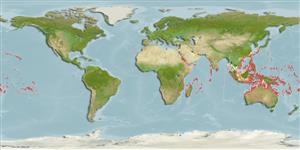Actinopterygii (ray-finned fishes) >
Perciformes (Perch-likes) >
Scaridae (Parrotfishes) > Scarinae
Etymology: Cetoscarus: Greek, ketos = a marine monster, whale + Greek, skaros = a fish cited by ancient writers; a parrot fish (Ref. 45335).
Issue
This species is endemic to the Red Sea (Ref. 54980:447, species treatment in prep). Correction of data in progress (information transfer to C. ocellatus of the Indo-Pacific).
Environment / Climate / Range
Ecology
Marine; reef-associated; depth range 1 - 30 m (Ref. 9710), usually 1 - 30 m (Ref. 27115). Tropical; 24°C - 28°C (Ref. 27115), preferred ?; 33°N - 25°S, 34°E - 134°W
Indo-Pacific: including the Red Sea.
Length at first maturity / Size / Weight / Age
Maturity: Lm 30.0 range ? - ? cm
Max length : 90.0 cm TL male/unsexed; (Ref. 2871)
Occurs in clear lagoon and seaward reefs (Ref. 1602). Juveniles usually solitary; adults form harems (Ref. 9710); males are territorial. Goes to several changes during growth and very large females change sex to the brightly colored male. Small juveniles usually in dense coral and algae habitats (Ref. 48636). Benthic grazer of algae (Ref. 3488). Caught with nets and other types of artisanal gear.
Life cycle and mating behavior
Maturity | Reproduction | Spawning | Eggs | Fecundity | Larvae
Oviparous, distinct pairing during breeding (Ref. 205).
Randall, J.E., G.R. Allen and R.C. Steene, 1990. Fishes of the Great Barrier Reef and Coral Sea. University of Hawaii Press, Honolulu, Hawaii. 506 p. (Ref. 2334)
IUCN Red List Status (Ref. 115185)
CITES (Ref. 94142)
Not Evaluated
Threat to humans
Harmless
Human uses
Fisheries: commercial; aquarium: commercial
More information
ReferencesAquacultureAquaculture profileStrainsGeneticsAllele frequenciesHeritabilityDiseasesProcessingMass conversion
Tools
Special reports
Download XML
Internet sources
